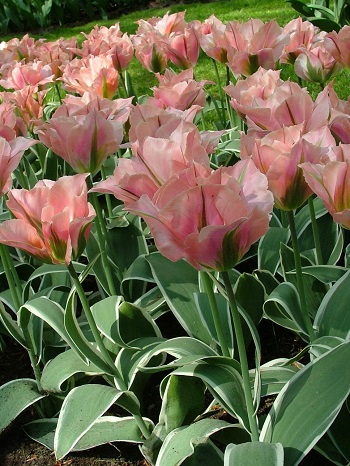
Green Tulip China Town makes spring worth waiting for. It noses its way into the world as the sun strengthens and the ground really warms up, after most of the early and mid-season bloomers have faded. Before you know it, China Town unfurls its striking white-edged, blue-green foliage like little garden explosions. That is when the real fun begins; don’t take your eyes off them for one day. Thick buds will emerge from the foliage, camouflaged by their matching, white-edged blue-greenness, poised for takeoff. One by one, the buds burst into pale pink flowers with prominent green feathering, perched above their two-tone foliage. Each day, particularly when planted in dappled sunlight, the flowers deepen in color, finally maturing to deep phlox-pink with somewhat less prominent green feathering.
In horticultural zone 5, it normally blooms in May depending on spring temperatures. It is a bit short for a late blooming Tulip, growing to just 12” tall, so it is perfect for border clusters where you can take advantage of its big show. China Town has the best marginated foliage of all Tulips with the thickest, most highly contrasted edging. The phenomenon of marginated foliage occurs due to a lack of or insufficient pigmentation and chlorophyll in the plant cells on the outer petal edges.
China Town is a long-lasting flower in the garden as well as the vase. It should be planted it in the fall after the soil has cooled to around 55°F, in neutral pH, well-draining soil in full to partial sunlight, a minimum of about six hours of daily sun: 6” to 8” deep and 6” apart. In areas warmer than horticultural zone 7, Tulip bulbs should be prechilled for a minimum of ten weeks starting in mid-October; otherwise, they will not develop mature root systems and will yield more foliage than flowers.
If you plan to grow them on for a potential second year of blooms, do not cut display beds for flower bouquets, top dress the planting three times a year with a granular organic flower bulb fertilizer (somewhere around 4-10-6 is a good composition), dead head spent flowers to prevent the formation of seed pods, and permit the foliage to thrive unfettered for the longest period of photosynthesis possible. Once the foliage dies back to a yellow-brown color, it may be raked and discarded. Take precautions with wildlife: Tulip bulbs could be snack food for tunneling rodents or marauding squirrels, and its flowers are a delicacy for brazen deer.
This plant profile was provided by Van Engelen Wholesale Flower Bulbs. For more information visit Vanengelen.com.
Related Articles & Free Email Newsletter Sign Up
Bamboo Orchid Combines the Best of Bamboo and Orchids
Caladiums Have Colorful, Large and Showy Leaves
Iris Blue Flag Fits Nicely into a Low Maintenance Landscaping Plan




Comment here